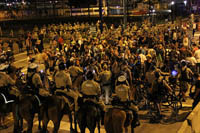Photograph courtesy of Lig Ynnek, Creative Commons
Earlier this month, a
Cleveland.com article asked if Tampa's approach to policing the RNC 2012 protests would "provide a blueprint for Cleveland as it prepares to host the next Republican National Convention a year from now?"
However, that may be the wrong question to ask.
Although Tampa can boast having hosted the most recent RNC with minimal amount of confrontation between police and protesters, the city was by no means protester-friendly, a claim that is repeatedly implied in the article.
Register to hear author Kris Hermes speak August 27 in Cleveland.
Akin to a “Police State”
It's true that there were fewer dissidents at the 2012 RNC than virtually any other political convention in recent memory (perhaps due to Hurricane Isaac), but the law enforcement apparatus established by the designation of "National Special Security Event" was as robust and intimidating as ever.
Tampa Police Chief Jane Castor said she outfitted a force of more than 5,000 officers. But there were only an estimated 500 protesters. That's 10 police officers for every one protester. A show of force that large is entirely unnecessary and clearly aimed at intimidating those who would dare to confront authority in the streets.
Castor emphasized her opposition to police wearing black gloves or having a threatening appearance. How about deploying less police?
And, who cares whether police are wearing black gloves if they're beating up protesters or shooting them with Tasers, projectile weapons, pepper spray or tear gas, as they've done at numerous contemporary mass demonstrations?
Cleveland Police Chief Calvin Williams said he "won't tolerate violence from anyone," but does that include violence perpetrated by his own police force?
Probably not.
Williams apparently wants to "assist people in exercising their First Amendment rights," but most activists I know don't want "assistance" from police.
The
Cleveland.com article also misses the mark on the importance of other police tactics seen not only in Tampa, but at every Republican convention since 2000. Illustrating its contempt for protest, police have routinely tried to relegate activists to a "protest pit," far enough from the convention site so as not to be heard or seen.
The area around the convention was akin to a militarized zone, with police armed with automatic weapons and tall fences and barricades heavily restricting the flow of people and traffic. Residents and convention delegates alike reported the area resembled a "police state."
One of the most unsettling tactics from law enforcement's playbook, used repeatedly over the past 15 years is the infiltration of political groups without probable cause. The
Cleveland.com article explains how police made "widespread use of undercover operatives to gather intelligence" in Tampa, but fails to explain how such tactics deny us our free speech rights.
And it gets worse.
Counter-Intelligence Tactics Suppress Dissent
At a recent "security" conference in Cleveland, Tampa Police Major Marc Hamlin bragged that the "organizational structure [of protesters] was extremely weak," and that undercover officers were able to infiltrate and "take over" the protest organization.
Admittedly, the use of infiltration has been normalized and the protections against its use have been eviscerated. However, police officers "taking over" a protest organization without cause is hardly discernible from the counterintelligence tactics of infiltration and disruption of political groups by the FBI. And they did it with complete impunity.
Plainclothes police in Tampa also infiltrated the demonstrations-another tactic from law enforcement's playbook-filming the protests and transmitting that information to a police command post, much like today's Fusion Centers that have proliferated across the country, including in
The claim by Tampa police that disruptions seen at previous conventions are due to "a lack of planning and coordination between agencies overseeing security" is laughable. The NSSE designation, used since 1998, places authority with the FBI and the U.S. Secret Service to establish one of the most robust and coordinated law enforcement apparatuses used in the country. There's certainly no reason those protesting the RNC in 2016-designated an NSSE-should expect anything different.
Tampa Police Chief Castor concedes that her police would probably have made more arrests if more protesters had shown up, but argues that she would never have "lost control."
After all, the contemporary model of policing political protests rests on a foundation of "control" that cannot be "lost" under any circumstance. Developed during the RNC 2000 protests in Philadelphia, shortly after police perceived a "loss of control" during the 1999 WTO protests in Seattle, today's model of policing dissent is often intolerant and violent.
The tactics cited here are, unfortunately, only a few of the ways in which police and the state have actively suppressed dissent.
As we approach the 2016 RNC, rather than using the typical repressive policing playbook, perhaps the most important question to ask is whether Cleveland will use its authority to violate people's rights or, instead, give real democracy a chance.
Kris Hermes is the author of “
Crashing the Party: Legacies and Lessons from the RNC 2000.
” This article originally appear in PM Press.

